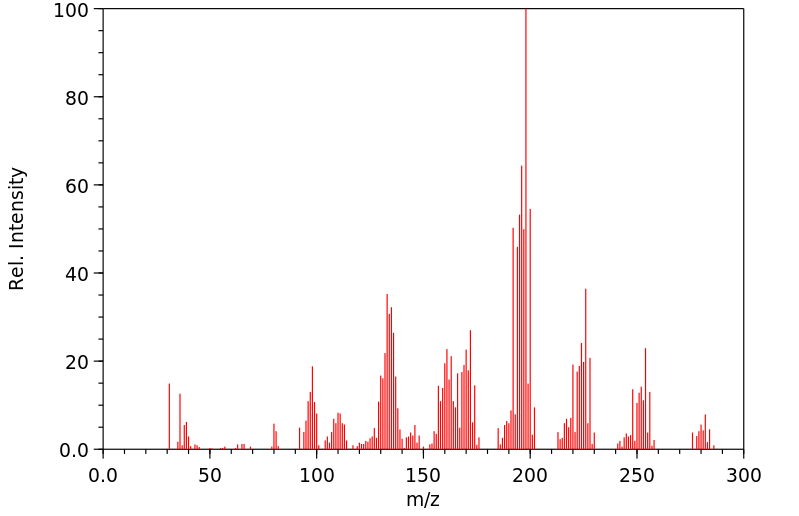(η5-cyclopentadienyl)MoCl(CO)3
中文名称
——
中文别名
——
英文名称
(η5-cyclopentadienyl)MoCl(CO)3
英文别名
——
CAS
——
化学式
C8H5ClMoO3
mdl
——
分子量
280.519
InChiKey
HNPPYXKLHDGBBD-UHFFFAOYSA-M
BEILSTEIN
——
EINECS
——
-
物化性质
-
计算性质
-
ADMET
-
安全信息
-
SDS
-
制备方法与用途
-
上下游信息
-
文献信息
-
表征谱图
-
同类化合物
-
相关功能分类
-
相关结构分类
计算性质
-
辛醇/水分配系数(LogP):None
-
重原子数:None
-
可旋转键数:None
-
环数:None
-
sp3杂化的碳原子比例:None
-
拓扑面积:None
-
氢给体数:None
-
氢受体数:None
反应信息
-
作为反应物:描述:参考文献:名称:含酮基和酰胺基膦的钼半三明治复合物的合成,结构表征和反应活性摘要:酮官能Ñ吡咯基膦配位体PPH 2 NC 4 H ^ 3 {C(O)CH 3 -2}大号1层发生反应以[代替MoCl(CO)3(η 5 -C 5 - [R 5)](R = H,我),得到[代替MoCl(CO)2(大号1 -κ 1 P)(η 5 -C 5 - [R 5)](R = H 1a中;箱1b中)。膦配体PPh 2 CH 2 C(O)Ph(L 2)和PPh 2CH 2 C(O)NPH 2(大号3)与反应[代替MoCl(CO)3(η 5 -C 5 - [R 5)〕以类似的方式,得到化合物〔代替MoCl(CO)2(L-κ 1个P)(η 5 -C 5 - [R 5)](L =大号2,R = H图2a中,Me 2B ; L =大号3,R = H图3a中,Me图3b)。化合物1 - 3与反应的AgBF 4,得到[沫(CO)2(L-κ2 P,ø)(η 5 -C 5 - [R 5)] BF 4(L =大号1,RDOI:10.1016/s0022-328x(02)02017-x
-
作为产物:描述:cyclopentadienylmolybdenum tricarbonyl dimer 在 四氯化碳 作用下, 以 四氯化碳 为溶剂, 以53%的产率得到(η5-cyclopentadienyl)MoCl(CO)3参考文献:名称:Davis, Reg; Groves, Ian F., Journal of the Chemical Society, Dalton Transactions, 1982, p. 2281 - 2288摘要:DOI:
文献信息
-
Investigation of the synthesis of {Mo(η<sup>5</sup>-C<sub>5</sub>H<sub>5</sub>)(CO)<sub>3</sub>}<sup>+</sup>fragments partnered with the monoanionic carboranes [closo-CB<sub>11</sub>H<sub>11</sub>Br]<sup>−</sup>, [closo-CB<sub>11</sub>H<sub>6</sub>Br<sub>6</sub>]<sup>−</sup>and [closo-HCB<sub>11</sub>Me<sub>11</sub>]<sup>−</sup>by silver salt metathesis and hydride abstraction作者:Nathan J. Patmore、Michael J. Ingleson、Mary F. Mahon、Andrew S. WellerDOI:10.1039/b303537a日期:——Abstraction of iodide from [Cp(CO)3MoI] (Cp = η5-C5H5) using the silver salt of the weakly coordinating anion [closo-CB11H11Br]â, initially affords an intermediate dimeric complex, [MoCp(CO)3I·Ag(CB11H11Br)]2, which has a central AgI}2 core appended by two carborane anions in the solid state. Prolonged reaction does result in elimination of AgI to form [MoCp(CO)3(CB11H11Br)], but not cleanly. This complex can be isolated in good yield by hydride abstraction from [Cp(CO)3MoH] using the new trityl salt [CPh3][closo-CB11H11Br]. Similarly, reaction of this hydride source with [CPh3][closo-CB11H6Br6] in CD2Cl2 results in hydride abstraction, but a mixture of products is formed, suggested to consist of the hydride bridged dimer, [Cp(CO)3Mo}2(μ-H)][closo-CB11H6Br6], the anion coordinated complex [Cp(CO)3Mo(closo-CB11H6Br6)] and the solvent adduct [Cp(CO)3Mo(ClCD2Cl)][closo-CB11H6Br6]. Reaction of Ag[closo-HCB11Me11] with [Cp(CO)3MoX] (X = Cl, I) results in a intermediate complex which has a [Cp(CO)3MoX]6Ag2 central core (crystallographically characterised for X = I) with no interactions from the permethylated carborane anions. Prolonged reaction does result in partial AgX elimination to form the halide-bridged dimers [CpMo(CO)3}2(μ-X)][closo-HCB11Me11]. Hydride abstraction from [Cp(CO)3MoH] using the new trityl salt [CPh3][closo-HCB11Me11] resulted in the clean formation of the hydride-bridged dimer [Cp(CO)3Mo}2(μ-H)][closo-HCB11Me11]. The two anions [closo-CB11H6Br6]â and [closo-HCB11Me11]â have been compared with [B(ArFâ²)4]â [ArFâ² = 3,5-bis(trifluoromethyl)phenyl] in Bullock's ionic hydrogenation of 3-pentanone using [Cp(CO)2(PPh3)Mo]+ catalysts. The permethylated anion slightly outperforms its hexabrominated congener in catalysis, but is still slower than [B(ArFâ²)4]â.从 [CP(CO)3MoI] 中提取碘化物 (CP = η5-C5H5) 使用弱配位阴离子 [closo-CB11H11Br]· 的银盐,最初提供中间二聚复合物 [MoCP(CO)3I·Ag(CB11H11Br)]2,其具有中心 AgI}2 核心附有两个固态碳硼烷阴离子。长时间的反应确实会导致 AgI 消除,形成 [MoCP(CO)3(CB11H11Br)],但不完全。使用新的三苯甲基盐 [CPh3][closo-CB11H11Br] 从 [CP(CO)3MoH] 中提取氢化物,可以以良好的产率分离出该配合物。类似地,该氢化物源与 CD2Cl2 中的 [CPh3][closo-CB11H6Br6] 反应导致氢化物提取,但形成了产物混合物,表明由氢化物桥联二聚体 [CP(CO)3Mo}2( μ-H)][closo-CB11H6Br6],阴离子配位络合物[CP(CO)3Mo(closo-CB11H6Br6)]和溶剂加合物[CP(CO)3Mo(ClCD2Cl)][closo-CB11H6Br6]。 Ag[closo-HCB11Me11] 与 [CP(CO)3MoX] 的反应 (X = Cl, I) 产生具有 [CP(CO)3MoX]6Ag2 中心核心(X = I 的晶体学特征)的中间复合物,与全甲基化碳硼烷阴离子没有相互作用。长时间的反应确实会导致部分 AgX 消除,形成卤化物桥联二聚体 [CPMo(CO)3}2(μ-X)][closo-HCB11Me11]。使用新的三苯甲基盐 [CPh3][closo-HCB11Me11] 从 [CP(CO)3MoH] 中提取氢化物导致氢化物桥联二聚体 [CP(CO)3Mo}2(μ-H)][ 的干净形成closeso-HCB11Me11]。已将两种阴离子 [closo-CB11H6Br6]‐ 和 [closo-HCB11Me11]‐ 与 [B(ArF‐²)4]‐ 进行了比较 [ArFâ² = 3,5-双(三氟甲基)苯基],使用 [CP(CO)2(PPh3)Mo]+ 催化剂进行 3-戊酮的布洛克离子氢化。全甲基化阴离子的催化性能略优于其六溴化同系物,但仍比 [B(ArF‐)4]‐ 慢。
-
Conformational analysis in diastereoisomer equilibria of square-pyramidal [C5H5(CO)2Mo pyridine-2-imine]PF6 complexes作者:Devendra K. Rastogi、Sharad RastogiDOI:10.1016/s0277-5387(00)87157-0日期:1982.1in the chemical shift of most of their 1H NMR signals and interconvert on heating in acetone-d6 at 80°C for 80 hr and 40°C for 200 hr. On the basis of three conformational determining effects (i) C-H or C-alkyl of the asymmetric centre eclipses the ligand plane, (ii) MC5H5/C6H5 attraction and (iii) MC5H5/alkyl repulsion in order of decreasing significance, the chemical shifts of the C5H5 signals, their
-
El-Hinnawi, Mahmoud A., Synthesis and Reactivity in Inorganic and Metal-Organic Chemistry, 1987, vol. 17, p. 191 - 200作者:El-Hinnawi, Mahmoud A.DOI:——日期:——
-
Brunner, Henri; Rastogi, Devendra K., Bulletin des Societes Chimiques Belges, 1980, vol. 89, # 10, p. 883 - 896作者:Brunner, Henri、Rastogi, Devendra K.DOI:——日期:——
-
Gaylani, Bann; Kilner, Melvyn; French, Christopher I., Acta Crystallographica, Section C: Crystal Structure Communications, 1991, vol. 47, p. 257 - 259作者:Gaylani, Bann、Kilner, Melvyn、French, Christopher I.、Pick, Alison J.、Wallwork, Stephen C.DOI:——日期:——
表征谱图
-
氢谱1HNMR
-
质谱MS
-
碳谱13CNMR
-
红外IR
-
拉曼Raman
-
峰位数据
-
峰位匹配
-
表征信息
同类化合物
黄原酸环癸酯
高纯三甲基锑
顺式-二氯二(环丙胺)铂(II)
顺式-二氯二(乙二胺)氯化铑(1+)
顺式-二(环己基丁氨合)二氯铂(II)
顺式-二(异丙基氨合)二氯铂(II)
顺式-(2-氨基甲基-1-环戊基氨合)二氯铂(II)
顺二氯二羰基铂(II)
顺-二氯双(乙二胺)氯化铱
雷(酸)汞[含水或水加乙醇≥20]
间碳硼烷-9-硫醇
镍,加合(7:2)钪
镉二(二戊基二硫代氨基甲酸盐)
镁,溴-6-庚烯基-
manganese carbide
butyl manganese bromide
锡烷,氯二环己基-
锡四丁醇
锑,(1:1)混合物和钪
锌叔-丁氧化物
锌,溴-1-丙烯基-,(E)-
锇,加合(2:1)钪
锆酸四丁酯
锂丁酯
锂4-异丙氧基-2-甲基-丁烷-2-醇
锂1-丁醇
锂(三氟甲基)乙炔化物
锂(3-氨基丙基)酰胺
铼五羰基碘化物
铼五羰基
银(I)2-羟基乙烷-1-硫醇盐
铯三氯三羰基锇
铬三乙二胺
铬,五羰基(环己胺)-,(OC-6-22)-
铬,二(乙酰腈)二氯-
铝,加合(3:1)钪
铜-乙二胺络合物
铜(II)乙二胺
铜(I)乙炔化物
铍,环戊-1,3-二烯,溴化
铊N,N-二正丁胺
铊,甲氧基二甲基-
铂(2+)二氯化3-甲基丁烷-1,2-二胺(1:1)
铁(3+)三(1-丁醇)
铁(2+)1,1'-(硫烷二基二-1,1-乙二基)二-2,4-环戊二烯化
铀,三甲基-
钾,[三(三甲基甲硅烷基)甲基]-
钴四异硫氰酸酯
钴,乙烷-1,2-二胺
钠辛基二硫代氨基甲酸酯







